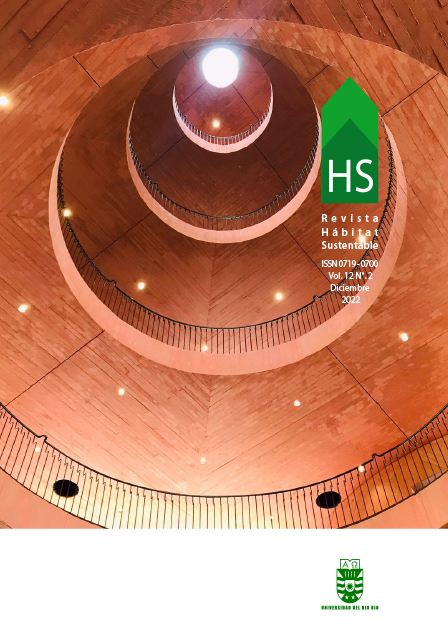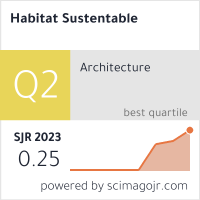Respuesta de los muros de quincha al riesgo de condensación
DOI:
https://doi.org/10.22320/07190700.2022.12.02.06Palabras clave:
quincha, humedad relativa, condensación superficial, condensación intersticialResumen
La respuesta de los muros de tierra frente a la humedad es un tema de relevancia al momento de evaluar la condensación superficial e intersticial. Por ello, en el siguiente artículo se analizó el comportamiento frente a la humedad de tres construcciones con muros de quincha, teniendo en cuenta las diferentes capas de revoque de barro y de cañas de Castilla. Primero, se evaluó respecto de la Norma Iram 11.625 y con los datos de temperatura exterior de diseño, la temperatura interior de diseño y las propiedades térmicas de los materiales. Se obtuvieron los valores de temperatura superficial y de rocío para cada caso. Se observó que, en ningún caso, se produjo condensación superficial y que en la capa cercana a la caña exterior existía, en todos los casos, la posibilidad de condensación intersticial, la cual puede ser optimizada mediante el uso de una aislación por la cara exterior o interior según la condición climática. A partir de mediciones in situ con dataloggers hobo, se tomaron registros de temperatura y humedad relativa interior y exterior para invierno. Se trazaron las curvas de temperatura superficial y de rocío y se advirtió que en todos los casos los valores de la temperatura de rocío son menores a la temperatura superficial, verificándose la falta de condensación superficial.
Descargas
Citas
ABADIE, M. y MENDOCA, K. (2009). Moisture performance of building materials: from material characterization to building simulation using the moisture buffer value concept. Bulding Environment, 44(2), 388-401.
ALASSAAD, F., TOUATI, K., LEVACHER, D. Y SEBAIBI, N. (2021). Impact of phase change materials on lightened earth hygroscopic, thermal and mechanical properties. Journal of Building Engineering, 41, 1-11.
ARIA JIMÉNEZ, N. y BOBADILLA MORENO, A. (2017). Evaluación experimental y análisis de la mejora con aislamiento para el caso del puente térmico en el frente de forjado. Informes de la Construcción, 69(546), 1-14.
ARUNDEL, A., STERLING, E., BIGGIN, J. y STERLING, T. (1986). Indirect health effects of relative humidity in indoor environments. Environmental Health Perspectives, 65, 351-361.
ASPHAUG, S., ANDENAS, E., GEVING, S., TIME, B. y KVANDE, T. (2022). Moisture-resilient performance of concrete basement walls – Numerical simulations of the effect of outward drying. Building and Environment, 222, 1-20.
BEINHAUER, P. (2009). Atlas de detalles constructivos. Rehabilitación. Barcelona: Gustavo Gili.
BERGER, J., GUERNOUTI, S., WOLOSZYN, M. y BUHE, C. (2015). Factors governing the development of moisture disorders for integration into building performance simulation. Journal of Building Engineering, 3, 1-15.
BERNABEU, M. (2019). La urbanización del agua en el Área Metropolitana de Mendoza. Estudios Sociales Contemporáneos, (21), 176-197.
BRUNO, A., GALLIPOLI, D., PERLOT, C. y KALLEL, H. (2020). Thermal performance of fired and unfired earth bricks walls. Journal of Building Engineering, 28, 1-17.
CÁRDENAS LLAMAS, R. y HERNÁNDEZ MENDOZA, C. (2003). Construcción de un prototipo de humidificación adiabática de aire para ensayos en el laboratorio de refrigeración y aire acondicionado de tecnológica de Bolivar. Cartagena de Indias: Facultad de ingenieria mecánica - Corporación Universitaria Tecnológica de Bolívar. Recuperado de: http://repositorio.utb.edu.co/bitstream/handle/20.500.12585/1969/0018980.pdf?sequence=1&isAllowed=y
CARDOSO, G., PUZHI, M. y ZHININ, S. (2016). Simulación de los Procesos Psicrométricos. Revista de la Facultad de Ciencias Química, (15), 25-39. Recuperado de: https://publicaciones.ucuenca.edu.ec/ojs/index.php/quimica/article/view/1613/1266
CASTILLA PASCUAL, F. (2004). Estabilización de morteros de barro para la protección de muros de tierra. Tesis doctoral. Madrid: E.T.S. Arquitectura (UPM). Recuperado de: https://oa.upm.es/8826/
COLINART, T., VINCESLAS, T., LENORMAND, H., HELLOUIN DE MENIBUS, A., HAMARD, E., y LECOMPTE, T. (2020). Hygrothermal properties of light-earth building materials. Journal of Building Engineering, 29, 101-134.
Corporación de Desarrollo Tecnológico - Cámara Chilena de la Construcción. (2012). Humedad por Condensación en Viviendas. Prevención y Soluciones. Chile: Área Comunicaciones, CDT.
COSCOLLANO RODRÍGUEZ, J. (2002). Ahorro energético en la Construcción y Rehabilitación de Edificio. Madrid: Thomson - Paraninfo.
COSTA-CARRAPIÇO, I., CROXFORD, B., RASLAN, R., y GONZÁLEZ, J. (2022). Hygrothermal calibration and validation of vernacular dwellings: A genetic algorithm-based optimisation methodology. Journal of Building Engineering, 55, 1-19.
DEL RÍO, J., CANIVELL, J., TORRES-GONZÁLEZ, M., ALBEA, E., HERNÁNDEZ, R., OCHOA, J. y SÁNCHEZ, F. (2021). Analysis of the materials and state of conservation of the medieval rammed earth walls of Seville (Spain). Journal of Building Engineering, 44, 1-15.
EcuRed (18 agosto 2021). Malargüe (Argentina). Recuperado de: https://www.ecured.cu/index.php?title=Malarg%C3%BCe_(Argentina)&oldid=4001273
ESHOJ, B. y PADFIELD, T. (1993). The use of porous building materials to provide a stable relative humidity. En ICOM-CC Conference (pp. 605-609), Washington DC. Recuperado de: https://www.icom-cc-publications-online.org/2817/The-Use-of-Porous-Building-Materials-to-Provide-a-Stable-Relative-Humidity
ESTEVES MIRAMONT, A. (2017). Arquitectura Bioclimática y Sustentable. Teoría y Práctica de la conservación de la energía, sistemas solares pasivos y enfriamiento natural de edificios. Mendoza: Esteves Alfredo.
FABBRI, A. y MOREL, J. (2016). Earthen materials and constructions. En Kent, H. y Bhavna, S. (Eds.), Nonconventional and Vernacular Construction Materials (pp. 273-299). Elsevier.
FERNÁNDEZ, E. y ESTEVES, A. (2004). Conservación de energía en sistemas autoconstruidos. El caso de la Quincha mejorada. Avances en Energías Renovables y Medio Ambiente, 8(1), 121-125.
FISAIR (2022). Fisair. Recuperado de: https://fisair.com/es/control-de-humedad-en-hospitales/
FOUCHAL, F., GOUNY, F., MAILLARD, P., ULMET, L. y ROSSIGNOL, S. (2015). Experimental evaluation of hydric performances of masonry walls made of earth bricks, geopolymer and wooden frame. Building and Environment, 87, 234-243.
FRESNO, M. (2021). Arquiteutu Tecnicu Na Rede. Recuperado de: https://arquiteututecnicu.com/2015/02/23/gestion-del-vapor-de-agua-en-muros-de-paja/
GEA-IZQUIERDO, E. (2022). Ambiente térmico en la investigación y docencia universitaria. Pensar, vivir y hacer la educación: Visiones compartidas. Vol. 3. Ecuador: Pontificia Universidad Católica del Ecuador.
GIADA, G., CAPONETTO, R. y NOCERA, F. (2019). Hygrothermal Properties of Raw Earth Materials: A Literature Review. Sustainability, 11(19), 1-21.
GONZÁLEZ SERRANO, A. (2015). Revocos de tierra cruda: Especificaciones técnicas para el empleo de morteros preparados de arcillas en construcción. Tesis Doctoral. Universidad de Sevilla. Recuperado de: https://idus.us.es/handle/11441/38210
GONZALO, G., LEDESMA, S., NOTA, V. y MARTÍNEZ, C. (2000). Rediseño y actualización del programa computacional para verificación del riesgo de condensación en cerramientos exteriores. Avances en Energías Revables y Medio Ambiente, 4(1).
HALL, M. y ALLINSON, D. (2009a). Assessing the effects of soil grading on the moisture content-dependent thermal conductivity of stabilised rammed earth materials. Applied Thermal Engineering, 29(4), 740-747.
HALL, M. y ALLINSON, D. (2009b). Analysis of the hygrothermal functional properties of stabilised rammed earth materials. Building and Environment, 44(9), 1935-1932.
HALL, M. y CASEY, S. (2012). Hygrothermal behaviour and occupant comfort in modern earth buildings. En M. Hall, R. Lindsay y M. Krayenhoff (Eds.), Modern earth buildings. Materials, engineering, construction and applications (pp. 17-40). Cambridge: Woodhead Publishing.
HAMDAOUI, M. A., BENZAAMA, M. H., MENDILI, y. Y CHATEIGNER, D. (2021). A review on physical and data-driven modeling of buildings hygrothermal behavior: Models, approaches and simulation tools. Energy and Buildings, 251, 3-11.
HENDRY, E. (2001). Masonry walls: materials and construction. Construction and Building Materials, 15(8), 323-330.
HUNG ANH, L. y PÁSZTORY, Z. (2021). An overview of factors influencing thermal conductivity of building insulation materials. Journal of Building Engineering, 44, 1-12.
INDEKEU, M., FENG, C., JANSSEN, H. y WOLOSZYN, M. (2021). Experimental study on the capillary absorption characteristics of rammed earth. Construction and Building Materials, 283, 1-13.
JANSSEN, H. ROELS, S. (2009). Qualitative and quantitative assessment of interior moisture buffering by enclosures. Energy and Buildings, 41(4), 382-394.
LABAT, M., MAGNIONT, C., OUDHOF, N. y AUBERT, J. E. (2016). From the experimental characterization of the hygrothermal properties of straw-clay mixtures to the numerical assessment of their buffering potential. Building and Environment, 97, 69-81.
LEE, H., OZAKI, A. y CHO, W. (2018). Evaluation of Anti-condensation Performance of External Walls with Fibrous Insulation. Earth and Environmental Science, 238(1), 1-9.
LIUZZI, S., HALL, M., STEFANIZZI, P. y CASEY, S. (2013). Hygrothermal behaviour and relative humidity buffering of unfired and hydrated lime-stabilised clay composites in a Mediterranean climate. Building and Environment, 61, 82-92.
MARTÍNEZ, P., SARMIENTO, P. y URQUIETA, W. (2005). Evaluación de la humedad por condensación al interior de las viviendasa sociales. Revista INVI, 20(055), 154-165.
MCGREGOR, F., HEATH, A., SHEA, A. y LAWRENCE, M. (2014). The moisture buffering capacity of unfired clay masonry. Building and Environment, 82, 599-607.
MINKE, G. (2005). Manual de construcción con tierra. La tierra como material de construcción y su aplicación en la arquitectura actual. Kassel: Fin de Siglo.
MIRANDA, A. (2007). Técnicas de climatización. Barcelona. México: Alfaomega-Marcombo.
NEMATCHOUA, M., TCHINDA, R., OROSA, J. y ANDREASI, W. (2015). Effect of wall construction materials over indoor air quality in humid and hot climate. Journal of Building Engineering, 3, 16-23.
Norma IRAM 11.625 (2000). Aislamiento térmico de edificios – Verificación de sus condiciones higrotérmicas. 41. Buenos Aires, Argentina.
Norma IRAM 11.601 (2002). Aislamiento térmico de edificios. Métodos de cálculo. 52. Buenos Aires, Argentina.
Norma IRAM 11.603 (2012). Condicionamiento térmico de edificios Clasificación bioambiental de la República Argentina. 43. Buenos Aires, Argentina.
Onset (9 junio 2022). Onset. Recuperado de: https://www.onsetcomp.com/datasheet/H08-003-02
PADFIELD, T. (1998). El papel de los materiales de construcción absorbentes en la moderación de los cambios de la humedad relativa. Dinamarca: Universidad Técnica de Dinamarca - Departamento de Ingeniería de Estructuras y Materiales.
RAMOS , N. y FREITAS, V. (2011). The evaluation of hygroscopic inertia and its importance to the hygrothermal performance of buildings. Heat Mass Transfer Porous Media, 13, 25-45.
RODE, C. y GRAU, K. (2008). Moisture buffering and its consequence in whole building hygrothermal modeling. Building Physics, 31(4), 333-360.
ROMERO ALONSO, J. (23 mayo 2022). ¿Cuál es la mejor forma de aislar tu vivienda? Los 8 mejores aislantes térmicos. Arrevol. Recuperado de: https://www.arrevol.com/blog/cual-es-la-mejor-forma-de-aislar-tu-vivienda-casa-los-8-mejores-aislantes-termicos
SANFULGENCIO TOMÉ, J. (16 mayo 2017). Tipos de humedades, cómo identificarlas y solucionarlas. Arrevol. Recuperado de: https://www.arrevol.com/blog/tipos-de-humedades-como-identificarlas-y-solucionarlas
Secretaría de Medio Ambiente (2009). Cartilla de contenidos mínimos ambientales para aprobar el examen de Conservación del Medio Ambiente. Mendoza: Gobierno de Mendoza.
SEDLBAUER, K. (2002). Prediction of mould growth by hygrothermal calculation. Journal of Thermal Envelope and Building Science, 25(4), 321-336.
Servicio Meteorológico Nacional Argentina. (2022). Recuperado de: https://www.smn.gob.ar/
STYLE, O. (febrero 2022). caloryfrio.com. Recuperado de: https://www.caloryfrio.com/construccion-sostenible/ventilacion-y-calidad-aire-interior/humedad-y-calidad-del-aire-cual-es-nivel-optimo-como-medirla.html
VEREECKEN, E., GELDER, L., JANSSEN, H. y ROELS, S. (2015). Interior insulation for wall retrofitting – A probabilistic analysis of energy savings and hygrothermal risks. Energy and Buildings, 89, 231-244.
ZHANG, L., SANG, G. y HAN, W. (2020). Effect of hygrothermal behaviour of earth brick on indoor environment in a desert climate. Sustainable Cities and Society, 55, 1-9.
Descargas
Publicado
Cómo citar
Número
Sección
Licencia
Derechos de autor 2022 Maria Guadalupe Cuitiño-Rosales, Alfredo Esteves-Miramont, Laura Elizabeth Najar

Esta obra está bajo una licencia internacional Creative Commons Atribución-CompartirIgual 4.0.
El contenido de los artículos que se publican en cada número de Hábitat Sustentable, es responsabilidad exclusiva de los autores y no representan necesariamente el pensamiento ni comprometen la opinión de la Universidad del Bío-Bío.
Los autores/as conservarán sus derechos de autor y garantizarán a la revista el derecho de primera publicación de su obra, el cuál estará simultáneamente sujeto a la Licencia de Reconocimiento de Creative Commons CC BY-SA que permite a otros compartir-copiar, transformar o crear nuevo material a partir de esta obra con fines no comerciales, siempre y cuando se reconozcan la autoría y la primera publicación en esta revista, y sus nuevas creaciones estén bajo una licencia con los mismos términos.











 Programa de Información Científica/Concurso Fondos de Publicación de Revistas Científicas 2018/ Proyecto Mejoramiento de Visibilidad de Revistas UBB (Código:FP180007)
Programa de Información Científica/Concurso Fondos de Publicación de Revistas Científicas 2018/ Proyecto Mejoramiento de Visibilidad de Revistas UBB (Código:FP180007) 





